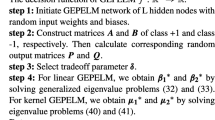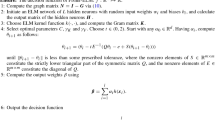Abstract
Semi-supervised learning is an attractive technique for using unlabeled data in classification. In this work, an efficient semi-supervised extreme learning machine (ELM) classification framework is proposed by introducing the Laplacian regularization term. It tries to build two nonparallel hyperplanes such that each hyperplane is closer to one of the two classes and farther away from the other class in ELM feature space, based on which, two new semi-supervised ELM classification algorithms are proposed. First, we formulate semi-supervised ELM as a ratio form, and reformulate it as a generalized eigenvalue problem (called Laplacian generalized eigenvalue extreme learning machine, LapGELM) to solve simply. Then we replace the form of ratio with a form of difference so that the optimization problems can be transformed into a standard eigenvalue problem (called Laplacian standard eigenvalue ELM, LapSELM) to control overfit and solve quickly. Furthermore, the proposed algorithms are implemented on various datasets with different sizes and structures. Compared with traditional methods, experiment results show the feasibility and effectiveness of the proposed algorithms due to their simplicity, rapidity, and good generalization performance.


















Similar content being viewed by others
References
Petros X, Panos P, Theodore T (2013) Robust data mining. https://doi.org/10.1007/978-1-4419-9878-1
Bauman E, Bauman K (2017) One-Class Semi-supervised Learning. In: Braverman Readings in Machine Learning, pp 189–200
K O, Soguero-Ruíz C, Bianchi FM, Jenssen R (2019) Noisy multi-label semi-supervised dimensionality reduction. Pattern Recognit 90:257–270
Joachims T (1999) Transductive inference for text classification using support vector machines. In: ICML
Bennett K, Demiriz A (1998) Semi-supervised support vector machines. In: NIPS
Huang G, Song S, Gupta J, Wu C (2014) Semi-supervised and unsupervised extreme learning machines. IEEE Trans Cybern 44:2405–2417
Luo X, Liu F, Yang S, Wang X, Zhou Z (2015) Joint sparse regularization based Sparse Semi-Supervised Extreme Learning Machine (S3ELM) for classification. Knowl Based Syst 73:149–160
Gomez-Chova L, Camps-Valls G, Munoz-Mari J, Calpe J (2008) Semisupervised image classification with Laplacian support vector machines. IEEE Geosci Remote Sens Lett 5(3):336–340. https://doi.org/10.1109/LGRS.2008.916070
Qi Z, Tian Y, Shi Y (2012) Laplacian twin support vector machine for semi-supervised classification. Neural Netw 35:46–53
Mangasarian O, Wild EW (2006) Multisurface proximal support vector machine classification via generalized eigenvalues. IEEE Trans Pattern Anal Mach Intell 28:69–74
Shao Y, Deng N, Chen W, Wang Z (2013) Improved generalized eigenvalue proximal support vector machine. IEEE Signal Process Lett 20:213–216
Tang L, Tian Y, Yang C, Pardalos P (2018) Ramp-loss nonparallel support vector regression: robust, sparse and scalable approximation. Knowl Based Syst 147:55–67
Viola M, Sangiovanni M, Toraldo G, Guarracino M (2019) Semi-supervised generalized eigenvalues classification. Ann Oper Res 276:249–266
Chen W, Shao Y, Xu D, Fu Y (2013) Manifold proximal support vector machine for semi-supervised classification. Appl Intell 40:623–638
Huang G, Zhu Q, Siew C (2006) Extreme learning machine: theory and applications. Neurocomputing 70:489–501
Zhou Z (2016) Machine learning. Tsinghua University Press, Beijing
Samat A, Du P, Liu S, Li JY, Cheng L (2014) \({{\rm E}^{2}}{\rm LMs}\): ensemble extreme learning machines for hyperspectral image classification. IEEE J Sel Top Appl Earth Obs Remote Sens 7:1060–1069
Qing Y, Zeng Y, Li Y, Huand G (2020) Deep and wide feature based extreme learning machine for image classification. Neurocomputing 412:426–436
Zhao Y, Huang G, Hu Q, Tan J, Wang J, Yang Z (2019) Soft extreme learning machine for fault detection of aircraft engine. Aerosp Sci Technol 91:70–81
Wang X, Yang K, Kalivas J (2020) Comparison of extreme learning machine models for gasoline octane number forecasting by near-infrared spectra analysis. Optik 200:163325
Wang Z, Xin J, Yang H, Tian S, Yu G, Xu C, Yao Y (2017) Distributed and weighted extreme learning machine for imbalanced big data learning. Tsinghua Sci Technol 22:160–173
Huang G, Ding X, Zhou H (2010) Optimization method based extreme learning machine for classification. Neurocomputing 74:155–163
Li S, Song S, Wan Y (2018) Laplacian twin extreme learning machine for semi-supervised classification. Neurocomputing 321:17–27
Yang J, Cao J, Wang T, Xue A, Chen B (2020) Regularized correntropy criterion based semi-supervised ELM. Neural Netw 122:117–129
Yang J, Cao J, Xue A (2020) Robust maximum mixture correntropy criterion based semi-supervised ELM with variable center. IEEE Trans Circuits Syst II Express Briefs 67:3572–3576
Ma J, Wen Y, Yang L (2020) Fisher-regularized supervised and semi-supervised extreme learning machine. Knowl Inf Syst 62:3995–4027
Krishnasamy G, Paramesran R (2016) Hessian semi-supervised extreme learning machine. Neurocomputing 207:560–567
Tang L, Tian Y, Pardalos P (2019) A novel perspective on multiclass classification: regular simplex support vector machine. Inf Sci 480:324–338
Acknowledgements
This work was supported in part by National Natural Science Foundation of China (No. 11471010) and Chinese Universities Scientific Fund.
Author information
Authors and Affiliations
Corresponding author
Additional information
Publisher's Note
Springer Nature remains neutral with regard to jurisdictional claims in published maps and institutional affiliations.
Rights and permissions
About this article
Cite this article
Wang, X., Yang, L. Laplacian Generalized Eigenvalues Extreme Learning Machine. Neural Process Lett 54, 467–499 (2022). https://doi.org/10.1007/s11063-021-10640-5
Accepted:
Published:
Issue Date:
DOI: https://doi.org/10.1007/s11063-021-10640-5




